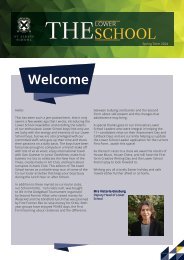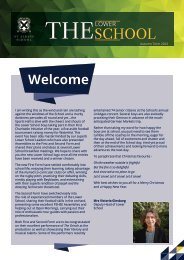Create successful ePaper yourself
Turn your PDF publications into a flip-book with our unique Google optimized e-Paper software.
62<br />
Hill End Hospital opened in St Albans (where<br />
Highfield Park stands today) in 1899, as Hertfordshire<br />
County Asylum, taking over from Bedford<br />
Asylum and Three Counties Asylum which had<br />
taken patients from Hertfordshire throughout the<br />
Victorian period. It was a typical hospital of its era,<br />
being mainly self-sufficient before World War Two<br />
with five farms, producing both crops and livestock,<br />
large gardens, a water pumping station and many<br />
services. Patients were largely the workers on these<br />
and a chapel (now Trestle Arts Base) was situated<br />
to the North of the site. Men and women were separated<br />
and their divisions were unequal, with larger<br />
blocks for female accommodation and more female<br />
blocks being added over subsequent years due to the<br />
gender imbalance – this could be put down to several<br />
factors, such as a damning of women as ‘hysterical’<br />
if they objected to the life that was imposed<br />
on them in this time or the admission of women for<br />
short term stays for ‘recovery from domestic lives’.<br />
One headstone that previously lay in the Garden<br />
of Rest at Highfield Park (where patients were<br />
generally buried in mass pauper graves) details<br />
Emily Evans, who died in 1901 (aged 55) and reads<br />
‘released from sorrow, sin and pain’. Her hospital<br />
records are ambiguous and no specific medical notes<br />
exist, with the register simply stating that she was<br />
diagnosed with dementia and the ‘duration of existing<br />
attack’ was ‘birth’ – it is unclear whether this<br />
is her own, or since she gave birth (possibly to an<br />
illegitimate child, given the ‘sin’ on her epitaph and<br />
the nature of her as a single woman with no trade<br />
or occupation). Hill End went through a period of<br />
severe hardship during World War One (common to<br />
most asylums) as extra residents from Norfolk led<br />
to overcrowding and male attendants left to join up.<br />
After this era, Hill End was renamed the Hertfordshire<br />
County Mental Hospital in 1920 to remove<br />
grim and unpleasant associations with the past, and<br />
then to Hill End Hospital for Mental and Nervous<br />
Diseases in 1936.<br />
During the pre- Second World War period, new<br />
‘heroic therapies’ were developed as psychologists<br />
and psychiatrists began to use a more experimental<br />
approach to treatment, with the idea that mental<br />
illness was based on physical issues in the nervous<br />
system or brain. Some of these treatments included<br />
insulin coma therapy, electroconvulsive therapy and<br />
psychosurgery (such as lobotomy). Largely seen<br />
as disturbing today due to their reckless and dangerous<br />
nature, some doctors may have been trying<br />
this to help their patients but many were treating<br />
The <strong>Gateway</strong> <strong>Chronicle</strong><br />
Above: Hill End Hospital<br />
their patients as less than human who could be<br />
forcefully experimented on to ‘empty the asylums’.<br />
This mistreatment continued at Hill End long after<br />
these practices had received public disapproval, and<br />
alleged abuse at Hill End Hospital Adolescent Unit<br />
in the 1970s and 1980s has been reported by over<br />
100 people leading to a three-year police inquiry.<br />
Hertfordshire police reported that ‘in some cases<br />
children were given adult doses’ of sedative medicine.<br />
Statements given included ‘We were beaten,<br />
we were punched, we were put in headlocks, we had<br />
our heads rammed into doors…I was one of the<br />
lucky ones because I wasn’t raped, but I know of<br />
other people who were’, ‘Your knickers were pulled<br />
down and you were jabbed. You just dropped to the<br />
floor immediately. You couldn’t move for two days’<br />
and ‘I’ve never, ever got over it’. Abuse of this scale<br />
was not taken seriously and could happen because<br />
of an apathetic public and an incompetent state who<br />
did not effectively manage patients or support them<br />
for rehabilitation, especially with adolescents who<br />
historically and currently feel a large stigma and<br />
harmful stereotypes attached to struggles with their<br />
mental health, which leads to further feelings of<br />
shame and isolation, preventing people from seeking<br />
out treatment. Another issue at Hill End and<br />
with the entire system was the misuse of it as a care<br />
centre for those who could not be cared for at home,<br />
no doubt exacerbated by Thatcher’s privatisation<br />
of social care. One woman described experiencing<br />
‘cruelty beyond belief ’ after being sent to Hill End<br />
due to being raped at home aged 13 despite her not<br />
having psychiatric problems – it was not known<br />
where to put her due to an ineffective mental health<br />
care system. Another stated ‘It was basically a psychiatric<br />
home being misused as a dumping ground


















